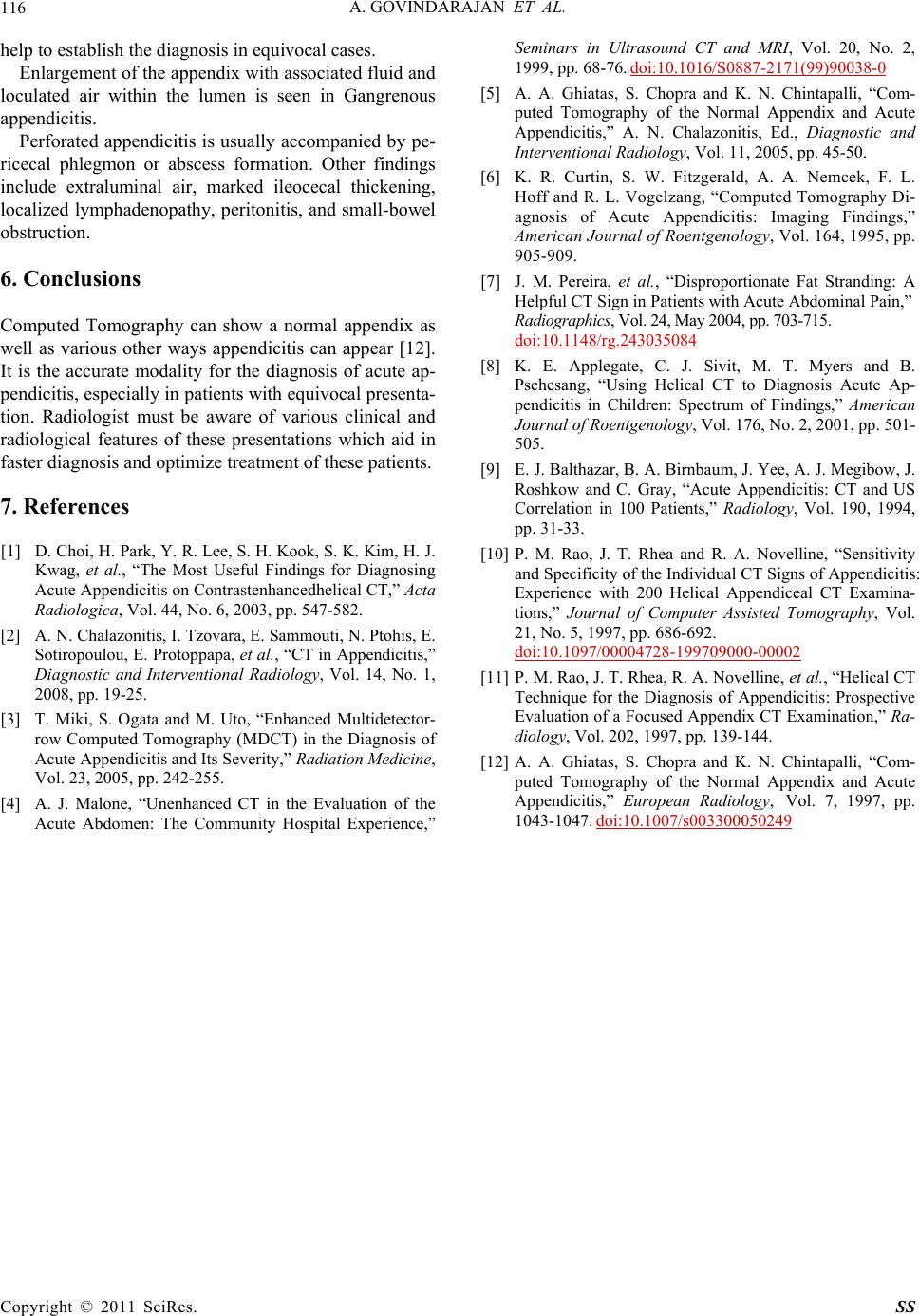
A. GOVINDARAJAN ET AL.
Copyright © 2011 SciRes. SS
116
help to establish the diagnosis in equivocal cases.
Enlargement of the appendix with associated fluid and
loculated air within the lumen is seen in Gangrenous
appendicitis.
Perforated appendicitis is usually accompanied by pe-
ricecal phlegmon or abscess formation. Other findings
include extraluminal air, marked ileocecal thickening,
localized lymphadenopathy, peritonitis, and small-bowel
obstruction.
6. Conclusions
Computed Tomography can show a normal appendix as
well as various other ways appendicitis can appear [12].
It is the accurate modality for the diagnosis of acute ap-
pendicitis, especially in patien ts with equivocal presenta-
tion. Radiologist must be aware of various clinical and
radiological features of these presentations which aid in
faster diagnosis and optimize treatment of these patients.
7. References
[1] D. Choi, H. Park, Y. R. Lee, S. H. Kook, S. K. Kim, H. J.
Kwag, et al., “The Most Useful Findings for Diagnosing
Acute Appendicitis on Contrastenhancedhelical CT,” Acta
Radiologica, Vol. 44, No. 6, 2003, pp. 547-582.
[2] A. N. Chalazonitis, I. Tzovara, E. Sammouti, N. Ptohis, E.
Sotiropoulou, E. Protoppapa, et al., “CT in Appendicitis,”
Diagnostic and Interventional Radiology, Vol. 14, No. 1,
2008, pp. 19-25.
[3] T. Miki, S. Ogata and M. Uto, “Enhanced Multidetector-
row Computed Tomography (MDCT) in the Diagnosis of
Acute Appendicitis and Its Severity,” Radiation Medicine,
Vol. 23, 2005, pp. 242-255.
[4] A. J. Malone, “Unenhanced CT in the Evaluation of the
Acute Abdomen: The Community Hospital Experience,”
Seminars in Ultrasound CT and MRI, Vol. 20, No. 2,
1999, pp. 68-76. doi:10.1016/S0887-2171(99)90038-0
[5] A. A. Ghiatas, S. Chopra and K. N. Chintapalli, “Com-
puted Tomography of the Normal Appendix and Acute
Appendicitis,” A. N. Chalazonitis, Ed., Diagnostic and
Interventional Radiology, Vol. 11, 2005, pp. 45-50.
[6] K. R. Curtin, S. W. Fitzgerald, A. A. Nemcek, F. L.
Hoff and R. L. Vogelzang, “Computed Tomography Di-
agnosis of Acute Appendicitis: Imaging Findings,”
American Journal of Roentgenology, Vol. 164, 1995, pp.
905-909.
[7] J. M. Pereira, et al., “Disproportionate Fat Stranding: A
Helpful CT Sign in Patients with Acute Abdominal Pain,”
Radiogra phic s, Vol. 24, May 2004, pp. 703-715.
doi:10.1148/rg.243035084
[8] K. E. Applegate, C. J. Sivit, M. T. Myers and B.
Pschesang, “Using Helical CT to Diagnosis Acute Ap-
pendicitis in Children: Spectrum of Findings,” American
Journal of Roentgenology, Vol. 176, No. 2, 2001, pp. 501-
505.
[9] E. J. Balthazar, B. A. Birnbaum, J. Yee, A. J. Megibow, J.
Roshkow and C. Gray, “Acute Appendicitis: CT and US
Correlation in 100 Patients,” Radiology, Vol. 190, 1994,
pp. 31-33.
[10] P. M. Rao, J. T. Rhea and R. A. Novelline, “Sensitivity
and Specificity of the Individual CT Signs of Appendicitis:
Experience with 200 Helical Appendiceal CT Examina-
tions,” Journal of Computer Assisted Tomography, Vol.
21, No. 5, 1997, pp. 686-692.
doi:10.1097/00004728-199709000-00002
[11] P. M. Rao, J. T. Rhea, R. A. Novelline, et al., “Helical CT
Technique for the Diagnosis of Appendicitis: Prospective
Evaluation of a Focused Appendix CT Examination,” Ra-
diology, Vol. 202, 1997, pp. 139-144.
[12] A. A. Ghiatas, S. Chopra and K. N. Chintapalli, “Com-
puted Tomography of the Normal Appendix and Acute
Appendicitis,” European Radiology, Vol. 7, 1997, pp.
1043-1047. doi:10.1007/s003300050249